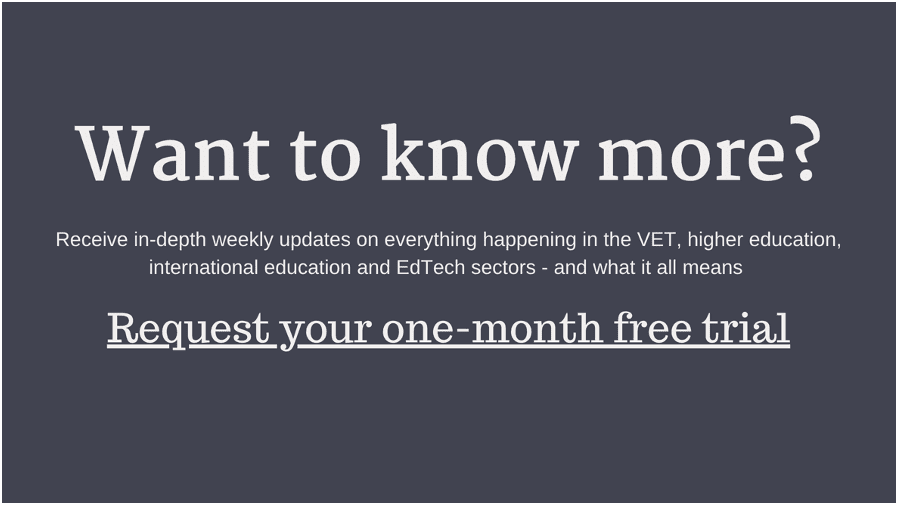
Is VET intelligent enough to get its response right on artificial intelligence?
I am aware that I’ve chosen a deliberately provocative headline for this piece, but it reflects my questions and concerns about where the VET sector in Australia is at in terms of responding to all forms of artificial intelligence but particularly generative AI.
There are two challenges tertiary education providers face in dealing with AI.
Firstly providers need to ensure their students are not using the technology to cheat. But secondly and equally importantly, they also need to ensure that they are preparing their students for a world of work which is being changed through the use of AI in different job roles and tasks.
The higher education regulator, TEQSA, has been world leading in its work in the last two years since the release of ChatGPT in its engagement with and support for the providers it regulates in understanding GenAI and its potential impact on teaching, assessment and research. Over time TEQSA has worked with experts from across the higher education sector to develop a raft of useful resources, and in more recent work to set clear expectations for Australian universities and non-university higher education providers in relation to Gen AI.
Sadly things are not nearly as advanced in VET. While ASQA’s research supporting the development of its current regulatory risk priorities has now recognised ‘AI technology’ as a potential contributor to an increased risk of academic cheating, it is yet to issue any guidance to the providers it regulates.

Academic integrity is of course as vital in VET as it is in higher education – so guidance and advice from the regulator is important in ensuring providers know what to be alert to and are provided with expert advice on how to manage the threats.[1]
What is also important – and requires a response from each sector (VET and higher education) – is ensuring that as job roles change as a result of AI that what we teach also changes.
Once again the means to tackle this issue is also easier for many higher education providers than for those in VET.
Almost a third of higher education providers (31%) have self-accrediting status. These universities, university colleges and some institutes of higher education collectively enrol more than 90% of all higher education students, and because of their self-accrediting status they can amend their course content at any time. So as long as they stay connected to industry, they can keep their course content current.
The same is not true in VET.
New VET qualifications reforms are designed to improve the VET qualification development process by shifting it away from a highly prescriptive focus on often very narrowly detailed units of competency, and into a new “purposed-based” approach which will “improve quality, simplify course designs and reduce complexity”. In future these reforms could make it easier to amend VET qualification content as job roles change but they will take time to roll out.
In addition, three TAFE Institutes have been delegated self-accrediting powers by ASQA, to develop new courses in priority industries linked to the TAFE Centres of Excellence.
But with 4,000 VET providers delivering qualifications which mostly come from existing national training packages ,which have taken years to develop because of the need for national consultations – it seems likely that it will be much harder for VET to keep its course content current in the next few years as the world of work changes.
Future Skills Organisation (FSO) has been leading work across the Jobs and Skills Councils on how GenAI is changing work in different industries. Within FSO’s sectors of business, finance and ICT they are making changes to four qualifications to accommodate changes to work practices to reflect the growing use of GenAI.
A November 2024 report by Jobs and Skills Australia (JSA) argued that “while new applications for AI are emerging every day, and it has the potential to revolutionise industries, streamline tasks and create new opportunities; evidence from current Australian internet job advertisement data suggests the take up of AI to date is modest and concentrated in particular industries and occupations.”
While I am deeply impressed by the work JSA does, I don’t think the VET sector can afford to rest on its laurels. Although the JSA research on AI and emerging occupations was published in late 2024, it examined changes in job roles occurring between 2018 and 2023. With ChatGPT (as the most well-known GenAI offering) only being launched publicly at the end of 2022, I would argue that by November 2024 the JSA findings were likely already somewhat out-of-date.
In its future program of work, JSA is working on a capacity study of GenAI implications for the labour market and education and training systems. I for one can’t wait to see it published – and I think it will be a much more important resource for the VET sector than higher education because of where the two sectors find themselves today in their engagement on this issue.
—————————————————————
[1] If you haven’t seen the TEQSA resources on dealing with GenAI yet, they can be accessed at: https://www.teqsa.gov.au/guides-resources/higher-education-good-practice-hub/artificial-intelligence
The Request for Information TEQSA issued to higher education providers in June 2024 also offers a useful set of questions for VET providers to use to start their thinking about how AI might be impacting their organisation.




